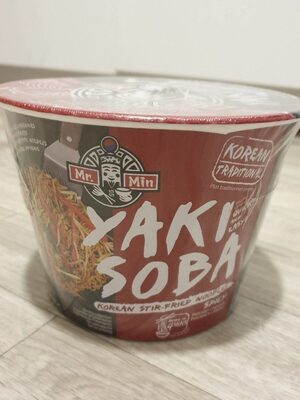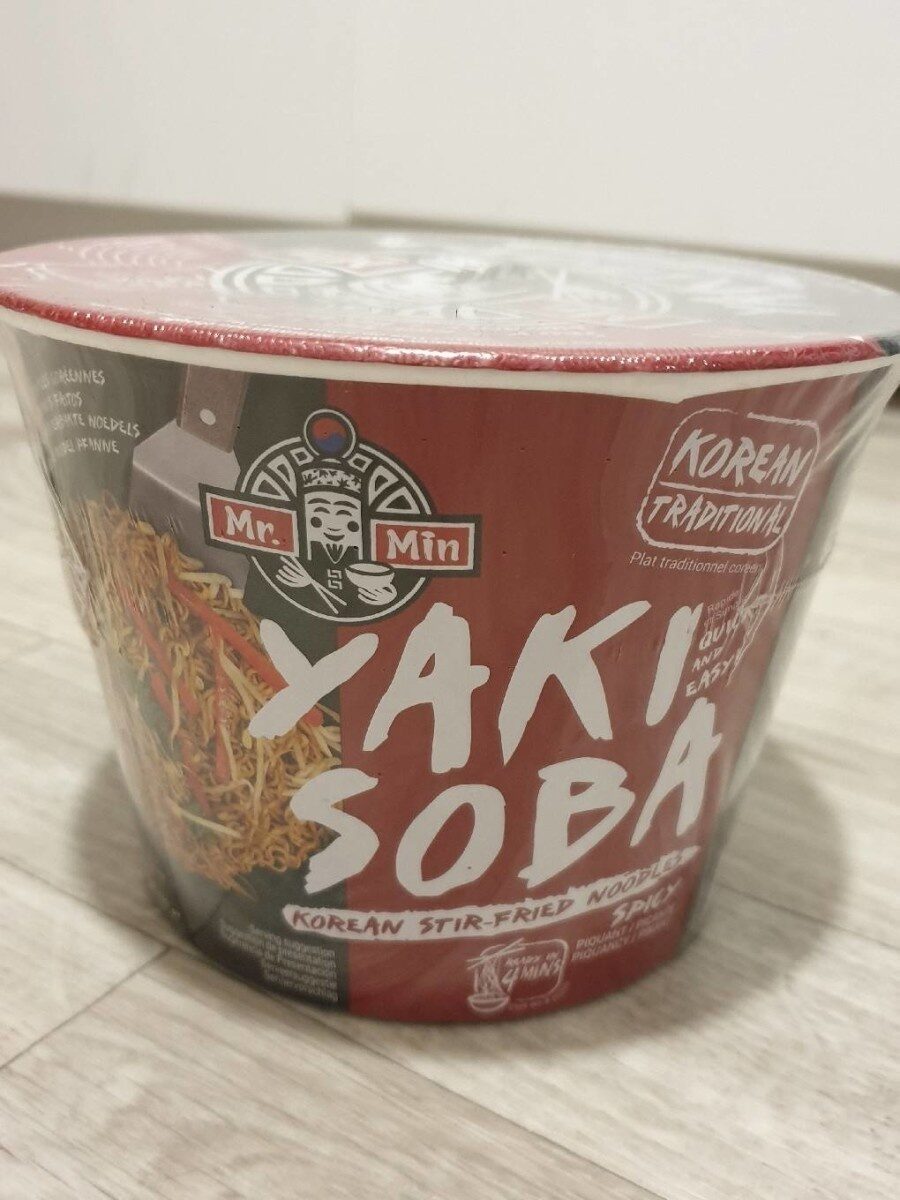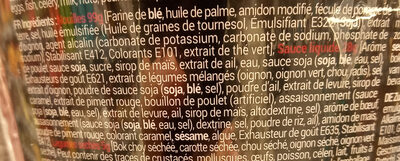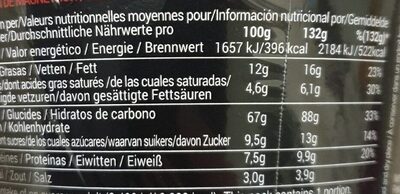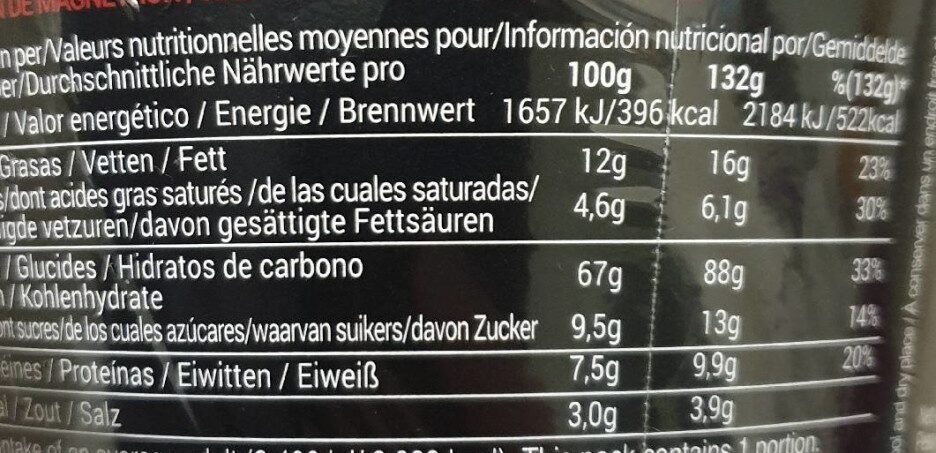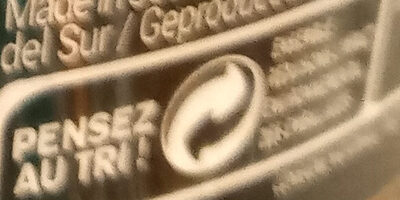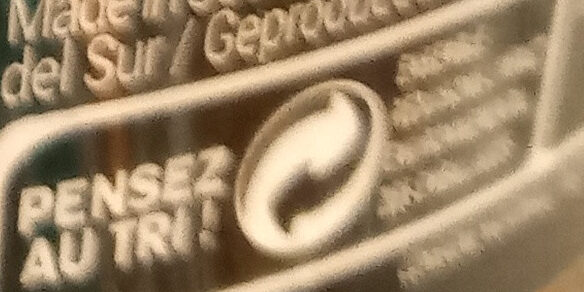Help us make food transparency the norm!
As a non-profit organization, we depend on your donations to continue informing consumers around the world about what they eat.
The food revolution starts with you!
Yakisoba - Mr. Min - 132 g
Yakisoba - Mr. Min - 132 g
This product page is not complete. You can help to complete it by editing it and adding more data from the photos we have, or by taking more photos using the app for Android or iPhone/iPad. Thank you!
×
Barcode: 8809419303076 (EAN / EAN-13)
Quantity: 132 g
Brands: Mr. Min
Categories: Plant-based foods and beverages, Plant-based foods, Cereals and potatoes, Cereals and their products, Meals, Dried products, Pastas, Dried products to be rehydrated, Noodles, Soups, Instant noodles
Stores: Franprix, carrefour.fr
Countries where sold: France
Matching with your preferences
Health
Ingredients
-
77 ingredients
: Nouilles 99g: Farine de blé, huile de palme, amidon modifié, fécule de pomme de terre sel huile émulsifiée (Huile de graines de tournesol, Emulsifiant E322 soja) extrait d'oignon agent alcalin (carbonate de potassium, carbonate de sodium, phosphate de sodium), Stabilisant E412, Colorants E101, extrait de thé vert), Sauce liquide 28g: Arôme de poulet sauce soja, sucre, sirop de maïs, extrait de ail, eau, sauce soja (soja, blé eau, sel), Exhausteurs de gout E621, extrait de légumes mélangés (oignon, oignon vert, chou, radis), sel. extrait d'oignon, poudre de sauce soja (soja, blé, sel), poudre d'ail, extrait de levure, sirop de caramel, extrait de piment rouge, bouillon de poulet (artificiel), assaisonnement (sauce soja (soja, blé, eau, sel), extrait de levure, ail, sirop de mais, altodextrine, sel), arôme de boeuf, assaisonnement (sauce soja (soja, blé, eau, sel), dextrine, sel, poudre de riz, ail), amidon de mais poudre de piment rouge, colorant caramel sésame algue. Exhausteur de goût E635 Stabilisant E412) Légumes séchés 5g: Bok choy séché, carotte séchée, chou séché, oignon séché, oignon vert séché pottichAllergens: Crustaceans, Gluten, Sesame seeds, SoybeansTraces: Celery, Eggs, Fish, Gluten, Milk, Molluscs, Mustard, Sesame seeds, Soybeans
Food processing
-
Ultra processed foods
Elements that indicate the product is in the 4 - Ultra processed food and drink products group:
- Additive: E101 - Riboflavin
- Additive: E1400 - Dextrin
- Additive: E14XX - Modified Starch
- Additive: E322 - Lecithins
- Additive: E412 - Guar gum
- Additive: E621 - Monosodium glutamate
- Additive: E635 - Disodium 5'-ribonucleotide
- Ingredient: Colour
- Ingredient: Emulsifier
- Ingredient: Flavour enhancer
- Ingredient: Flavouring
Food products are classified into 4 groups according to their degree of processing:
- Unprocessed or minimally processed foods
- Processed culinary ingredients
- Processed foods
- Ultra processed foods
The determination of the group is based on the category of the product and on the ingredients it contains.
Additives
-
E101 - Riboflavin
Riboflavin: Riboflavin, also known as vitamin B2, is a vitamin found in food and used as a dietary supplement. Food sources include eggs, green vegetables, milk and other dairy product, meat, mushrooms, and almonds. Some countries require its addition to grains. As a supplement it is used to prevent and treat riboflavin deficiency and prevent migraines. It may be given by mouth or injection.It is nearly always well tolerated. Normal doses are safe during pregnancy. Riboflavin is in the vitamin B group. It is required by the body for cellular respiration.Riboflavin was discovered in 1920, isolated in 1933, and first made in 1935. It is on the World Health Organization's List of Essential Medicines, the most effective and safe medicines needed in a health system. Riboflavin is available as a generic medication and over the counter. In the United States a month of supplements costs less than 25 USD.Source: Wikipedia
-
E1400 - Dextrin
Dextrin: Dextrins are a group of low-molecular-weight carbohydrates produced by the hydrolysis of starch or glycogen. Dextrins are mixtures of polymers of D-glucose units linked by α--1→4- or α--1→6- glycosidic bonds. Dextrins can be produced from starch using enzymes like amylases, as during digestion in the human body and during malting and mashing, or by applying dry heat under acidic conditions -pyrolysis or roasting-. The latter process is used industrially, and also occurs on the surface of bread during the baking process, contributing to flavor, color and crispness. Dextrins produced by heat are also known as pyrodextrins. The starch hydrolyses during roasting under acidic conditions, and short-chained starch parts partially rebranch with α--1‚6- bonds to the degraded starch molecule. See also Maillard Reaction. Dextrins are white, yellow, or brown powders that are partially or fully water-soluble, yielding optically active solutions of low viscosity. Most of them can be detected with iodine solution, giving a red coloration; one distinguishes erythrodextrin -dextrin that colours red- and achrodextrin -giving no colour-. White and yellow dextrins from starch roasted with little or no acid are called British gum.Source: Wikipedia
-
E322 - Lecithins
Lecithins are natural compounds commonly used in the food industry as emulsifiers and stabilizers.
Extracted from sources like soybeans and eggs, lecithins consist of phospholipids that enhance the mixing of oil and water, ensuring smooth textures in various products like chocolates, dressings, and baked goods.
They do not present any known health risks.
-
E339 - Sodium phosphates
Sodium phosphates: Sodium phosphate is a generic term for a variety of salts of sodium -Na+- and phosphate -PO43−-. Phosphate also forms families or condensed anions including di-, tri-, tetra-, and polyphosphates. Most of these salts are known in both anhydrous -water-free- and hydrated forms. The hydrates are more common than the anhydrous forms.Source: Wikipedia
-
E412 - Guar gum
Guar gum (E412) is a natural food additive derived from guar beans.
This white, odorless powder is valued for its remarkable thickening and stabilizing properties, making it a common ingredient in various food products, including sauces, dressings, and ice creams.
When used in moderation, guar gum is considered safe for consumption, with no known adverse health effects.
-
E500 - Sodium carbonates
Sodium carbonates (E500) are compounds commonly used in food preparation as leavening agents, helping baked goods rise by releasing carbon dioxide when they interact with acids.
Often found in baking soda, they regulate the pH of food, preventing it from becoming too acidic or too alkaline. In the culinary world, sodium carbonates can also enhance the texture and structure of foods, such as noodles, by modifying the gluten network.
Generally recognized as safe, sodium carbonates are non-toxic when consumed in typical amounts found in food.
-
E500i - Sodium carbonate
Sodium carbonate: Sodium carbonate, Na2CO3, -also known as washing soda, soda ash and soda crystals, and in the monohydrate form as crystal carbonate- is the water-soluble sodium salt of carbonic acid. It most commonly occurs as a crystalline decahydrate, which readily effloresces to form a white powder, the monohydrate. Pure sodium carbonate is a white, odorless powder that is hygroscopic -absorbs moisture from the air-. It has a strongly alkaline taste, and forms a moderately basic solution in water. Sodium carbonate is well known domestically for its everyday use as a water softener. Historically it was extracted from the ashes of plants growing in sodium-rich soils, such as vegetation from the Middle East, kelp from Scotland and seaweed from Spain. Because the ashes of these sodium-rich plants were noticeably different from ashes of timber -used to create potash-, they became known as "soda ash". It is synthetically produced in large quantities from salt -sodium chloride- and limestone by a method known as the Solvay process. The manufacture of glass is one of the most important uses of sodium carbonate. Sodium carbonate acts as a flux for silica, lowering the melting point of the mixture to something achievable without special materials. This "soda glass" is mildly water-soluble, so some calcium carbonate is added to the melt mixture to make the glass produced insoluble. This type of glass is known as soda lime glass: "soda" for the sodium carbonate and "lime" for the calcium carbonate. Soda lime glass has been the most common form of glass for centuries. Sodium carbonate is also used as a relatively strong base in various settings. For example, it is used as a pH regulator to maintain stable alkaline conditions necessary for the action of the majority of photographic film developing agents. It acts as an alkali because when dissolved in water, it dissociates into the weak acid: carbonic acid and the strong alkali: sodium hydroxide. This gives sodium carbonate in solution the ability to attack metals such as aluminium with the release of hydrogen gas.It is a common additive in swimming pools used to raise the pH which can be lowered by chlorine tablets and other additives which contain acids. In cooking, it is sometimes used in place of sodium hydroxide for lyeing, especially with German pretzels and lye rolls. These dishes are treated with a solution of an alkaline substance to change the pH of the surface of the food and improve browning. In taxidermy, sodium carbonate added to boiling water will remove flesh from the bones of animal carcasses for trophy mounting or educational display. In chemistry, it is often used as an electrolyte. Electrolytes are usually salt-based, and sodium carbonate acts as a very good conductor in the process of electrolysis. In addition, unlike chloride ions, which form chlorine gas, carbonate ions are not corrosive to the anodes. It is also used as a primary standard for acid-base titrations because it is solid and air-stable, making it easy to weigh accurately.Source: Wikipedia
-
E501 - Potassium carbonates
Potassium carbonate: Potassium carbonate -K2CO3- is a white salt, which is soluble in water -insoluble in ethanol- and forms a strongly alkaline solution. It can be made as the product of potassium hydroxide's absorbent reaction with carbon dioxide. It is deliquescent, often appearing a damp or wet solid. Potassium carbonate is used in the production of soap and glass.Source: Wikipedia
-
E501i - Potassium carbonate
Potassium carbonate: Potassium carbonate -K2CO3- is a white salt, which is soluble in water -insoluble in ethanol- and forms a strongly alkaline solution. It can be made as the product of potassium hydroxide's absorbent reaction with carbon dioxide. It is deliquescent, often appearing a damp or wet solid. Potassium carbonate is used in the production of soap and glass.Source: Wikipedia
-
E621 - Monosodium glutamate
Monosodium glutamate: Monosodium glutamate -MSG, also known as sodium glutamate- is the sodium salt of glutamic acid, one of the most abundant naturally occurring non-essential amino acids. Glutamic acid is found naturally in tomatoes, grapes, cheese, mushrooms and other foods.MSG is used in the food industry as a flavor enhancer with an umami taste that intensifies the meaty, savory flavor of food, as naturally occurring glutamate does in foods such as stews and meat soups. It was first prepared in 1908 by Japanese biochemist Kikunae Ikeda, who was trying to isolate and duplicate the savory taste of kombu, an edible seaweed used as a base for many Japanese soups. MSG as a flavor enhancer balances, blends, and rounds the perception of other tastes.The U.S. Food and Drug Administration has given MSG its generally recognized as safe -GRAS- designation. A popular belief is that large doses of MSG can cause headaches and other feelings of discomfort, known as "Chinese restaurant syndrome," but double-blind tests fail to find evidence of such a reaction. The European Union classifies it as a food additive permitted in certain foods and subject to quantitative limits. MSG has the HS code 29224220 and the E number E621.Source: Wikipedia
Ingredients analysis
-
Palm oil
Ingredients that contain palm oil: Palm oil
-
Non-vegan
Non-vegan ingredients: Chicken broth, Beef flavouringSome ingredients could not be recognized.
We need your help!
You can help us recognize more ingredients and better analyze the list of ingredients for this product and others:
- Edit this product page to correct spelling mistakes in the ingredients list, and/or to remove ingredients in other languages and sentences that are not related to the ingredients.
- Add new entries, synonyms or translations to our multilingual lists of ingredients, ingredient processing methods, and labels.
If you would like to help, join the #ingredients channel on our Slack discussion space and/or learn about ingredients analysis on our wiki. Thank you!
-
Non-vegetarian
Non-vegetarian ingredients: Chicken broth, Beef flavouringSome ingredients could not be recognized.
We need your help!
You can help us recognize more ingredients and better analyze the list of ingredients for this product and others:
- Edit this product page to correct spelling mistakes in the ingredients list, and/or to remove ingredients in other languages and sentences that are not related to the ingredients.
- Add new entries, synonyms or translations to our multilingual lists of ingredients, ingredient processing methods, and labels.
If you would like to help, join the #ingredients channel on our Slack discussion space and/or learn about ingredients analysis on our wiki. Thank you!
-
Details of the analysis of the ingredients
We need your help!
Some ingredients could not be recognized.
We need your help!
You can help us recognize more ingredients and better analyze the list of ingredients for this product and others:
- Edit this product page to correct spelling mistakes in the ingredients list, and/or to remove ingredients in other languages and sentences that are not related to the ingredients.
- Add new entries, synonyms or translations to our multilingual lists of ingredients, ingredient processing methods, and labels.
If you would like to help, join the #ingredients channel on our Slack discussion space and/or learn about ingredients analysis on our wiki. Thank you!
: Nouilles (Farine de _blé_), huile de palme, amidon modifié, fécule de pomme de terre sel huile émulsifiée (Huile de graines de tournesol, Emulsifiant (e322 _soja_)), extrait d'oignon agent alcalin (carbonate de potassium, carbonate de sodium, phosphate de sodium), Stabilisant (e412), Colorants (e101), extrait de thé vert, Sauce (Arôme de poulet sauce _soja_), sucre, sirop de maïs, extrait de ail, eau, sauce _soja_ (_soja_, _blé_ eau, sel), Exhausteurs de gout (e621), extrait de légumes mélangés (oignon, oignon vert, chou, radis), sel, extrait d'oignon, sauce _soja_ (_soja_, _blé_, sel), ail, extrait de levure, sirop de caramel, piment rouge, bouillon de poulet (artificiel), assaisonnement (sauce _soja_ (_soja_, _blé_, eau, sel), extrait de levure, ail, sirop de mais, altodextrine, sel), arôme de boeuf, assaisonnement (sauce _soja_ (_soja_, _blé_, eau, sel), dextrine, sel, riz, ail), amidon de mais poudre de piment rouge, colorant caramel _sésame_ algue, Exhausteur de goût (e635 Stabilisant e412) Légumes séchés), Bok choy, carotte séchée, chou, oignon séché, oignon vert séché pottich- Nouilles -> en:noodle - vegan: maybe - vegetarian: maybe - percent_min: 2.85714285714286 - percent_max: 100
- Farine de _blé_ -> en:wheat-flour - vegan: yes - vegetarian: yes - ciqual_proxy_food_code: 9410 - percent_min: 2.85714285714286 - percent_max: 100
- huile de palme -> en:palm-oil - vegan: yes - vegetarian: yes - from_palm_oil: yes - ciqual_food_code: 16129 - percent_min: 0 - percent_max: 50
- amidon modifié -> en:modified-starch - vegan: yes - vegetarian: yes - ciqual_proxy_food_code: 9510 - percent_min: 0 - percent_max: 33.3333333333333
- fécule de pomme de terre sel huile émulsifiée -> fr:fecule-de-pomme-de-terre-sel-huile-emulsifiee - percent_min: 0 - percent_max: 25
- Huile de graines de tournesol -> en:sunflower-oil - vegan: yes - vegetarian: yes - from_palm_oil: no - ciqual_food_code: 17440 - percent_min: 0 - percent_max: 25
- Emulsifiant -> en:emulsifier - percent_min: 0 - percent_max: 12.5
- e322 _soja_ -> en:soya-lecithin - vegan: yes - vegetarian: yes - ciqual_food_code: 42200 - percent_min: 0 - percent_max: 12.5
- extrait d'oignon agent alcalin -> fr:extrait-d-oignon-agent-alcalin - percent_min: 0 - percent_max: 20
- carbonate de potassium -> en:e501i - vegan: yes - vegetarian: yes - percent_min: 0 - percent_max: 20
- carbonate de sodium -> en:e500i - vegan: yes - vegetarian: yes - percent_min: 0 - percent_max: 10
- phosphate de sodium -> en:e339 - vegan: yes - vegetarian: yes - percent_min: 0 - percent_max: 6.66666666666667
- Stabilisant -> en:stabiliser - percent_min: 0 - percent_max: 16.6666666666667
- e412 -> en:e412 - vegan: yes - vegetarian: yes - percent_min: 0 - percent_max: 16.6666666666667
- Colorants -> en:colour - percent_min: 0 - percent_max: 14.2857142857143
- e101 -> en:e101 - vegan: maybe - vegetarian: yes - percent_min: 0 - percent_max: 14.2857142857143
- extrait de thé vert -> en:green-tea-extract - vegan: yes - vegetarian: yes - ciqual_food_code: 18155 - percent_min: 0 - percent_max: 12.5
- Sauce -> en:sauce - vegan: maybe - vegetarian: maybe - percent_min: 0 - percent_max: 11.1111111111111
- Arôme de poulet sauce _soja_ -> fr:arome-de-poulet-sauce-soja - percent_min: 0 - percent_max: 11.1111111111111
- sucre -> en:sugar - vegan: yes - vegetarian: yes - ciqual_proxy_food_code: 31016 - percent_min: 0 - percent_max: 9.5
- sirop de maïs -> en:corn-syrup - vegan: yes - vegetarian: yes - ciqual_proxy_food_code: 31089 - percent_min: 0 - percent_max: 9.09090909090909
- extrait de ail -> en:garlic-extract - vegan: yes - vegetarian: yes - ciqual_food_code: 11000 - percent_min: 0 - percent_max: 8.33333333333333
- eau -> en:water - vegan: yes - vegetarian: yes - ciqual_food_code: 18066 - percent_min: 0 - percent_max: 7.69230769230769
- sauce _soja_ -> en:soy-sauce - vegan: maybe - vegetarian: maybe - ciqual_food_code: 11104 - percent_min: 0 - percent_max: 7.14285714285714
- _soja_ -> en:soya - vegan: yes - vegetarian: yes - percent_min: 0 - percent_max: 7.14285714285714
- _blé_ eau -> fr:ble-eau - percent_min: 0 - percent_max: 3.57142857142857
- sel -> en:salt - vegan: yes - vegetarian: yes - ciqual_food_code: 11058 - percent_min: 0 - percent_max: 2.38095238095238
- Exhausteurs de gout -> en:flavour-enhancer - percent_min: 0 - percent_max: 6.66666666666667
- e621 -> en:e621 - vegan: yes - vegetarian: yes - percent_min: 0 - percent_max: 6.66666666666667
- extrait de légumes mélangés -> fr:extrait-de-legumes-melanges - percent_min: 0 - percent_max: 6.25
- oignon -> en:onion - vegan: yes - vegetarian: yes - ciqual_food_code: 20034 - percent_min: 0 - percent_max: 6.25
- oignon vert -> en:spring-onion - vegan: yes - vegetarian: yes - ciqual_food_code: 11003 - percent_min: 0 - percent_max: 3.125
- chou -> en:cabbage - vegan: yes - vegetarian: yes - percent_min: 0 - percent_max: 2.08333333333333
- radis -> en:radish - vegan: yes - vegetarian: yes - ciqual_food_code: 20045 - percent_min: 0 - percent_max: 1.5625
- sel -> en:salt - vegan: yes - vegetarian: yes - ciqual_food_code: 11058 - percent_min: 0 - percent_max: 3
- extrait d'oignon -> en:onion-extract - vegan: yes - vegetarian: yes - ciqual_food_code: 20034 - percent_min: 0 - percent_max: 3
- sauce _soja_ -> en:soy-sauce - vegan: maybe - vegetarian: maybe - ciqual_food_code: 11104 - percent_min: 0 - percent_max: 3
- _soja_ -> en:soya - vegan: yes - vegetarian: yes - percent_min: 0 - percent_max: 3
- _blé_ -> en:wheat - vegan: yes - vegetarian: yes - ciqual_proxy_food_code: 9410 - percent_min: 0 - percent_max: 1.5
- sel -> en:salt - vegan: yes - vegetarian: yes - ciqual_food_code: 11058 - percent_min: 0 - percent_max: 1
- ail -> en:garlic - vegan: yes - vegetarian: yes - ciqual_food_code: 11000 - percent_min: 0 - percent_max: 3
- extrait de levure -> en:yeast-extract - vegan: yes - vegetarian: yes - percent_min: 0 - percent_max: 3
- sirop de caramel -> en:caramel-syrup - percent_min: 0 - percent_max: 3
- piment rouge -> en:red-chili-pepper - vegan: yes - vegetarian: yes - ciqual_food_code: 20151 - percent_min: 0 - percent_max: 3
- bouillon de poulet -> en:chicken-broth - vegan: no - vegetarian: no - ciqual_food_code: 11174 - percent_min: 0 - percent_max: 3
- artificiel -> fr:artificiel - percent_min: 0 - percent_max: 3
- assaisonnement -> en:condiment - vegan: maybe - vegetarian: maybe - percent_min: 0 - percent_max: 3
- sauce _soja_ -> en:soy-sauce - vegan: maybe - vegetarian: maybe - ciqual_food_code: 11104 - percent_min: 0 - percent_max: 3
- _soja_ -> en:soya - vegan: yes - vegetarian: yes - percent_min: 0 - percent_max: 3
- _blé_ -> en:wheat - vegan: yes - vegetarian: yes - ciqual_proxy_food_code: 9410 - percent_min: 0 - percent_max: 1.5
- eau -> en:water - vegan: yes - vegetarian: yes - ciqual_food_code: 18066 - percent_min: 0 - percent_max: 1
- sel -> en:salt - vegan: yes - vegetarian: yes - ciqual_food_code: 11058 - percent_min: 0 - percent_max: 0.75
- extrait de levure -> en:yeast-extract - vegan: yes - vegetarian: yes - percent_min: 0 - percent_max: 1.5
- ail -> en:garlic - vegan: yes - vegetarian: yes - ciqual_food_code: 11000 - percent_min: 0 - percent_max: 1
- sirop de mais -> en:corn-syrup - vegan: yes - vegetarian: yes - ciqual_proxy_food_code: 31089 - percent_min: 0 - percent_max: 0.75
- altodextrine -> fr:altodextrine - percent_min: 0 - percent_max: 0.6
- sel -> en:salt - vegan: yes - vegetarian: yes - ciqual_food_code: 11058 - percent_min: 0 - percent_max: 0.5
- sauce _soja_ -> en:soy-sauce - vegan: maybe - vegetarian: maybe - ciqual_food_code: 11104 - percent_min: 0 - percent_max: 3
- arôme de boeuf -> en:beef-flavouring - vegan: no - vegetarian: no - percent_min: 0 - percent_max: 3
- assaisonnement -> en:condiment - vegan: maybe - vegetarian: maybe - percent_min: 0 - percent_max: 3
- sauce _soja_ -> en:soy-sauce - vegan: maybe - vegetarian: maybe - ciqual_food_code: 11104 - percent_min: 0 - percent_max: 3
- _soja_ -> en:soya - vegan: yes - vegetarian: yes - percent_min: 0 - percent_max: 3
- _blé_ -> en:wheat - vegan: yes - vegetarian: yes - ciqual_proxy_food_code: 9410 - percent_min: 0 - percent_max: 1.5
- eau -> en:water - vegan: yes - vegetarian: yes - ciqual_food_code: 18066 - percent_min: 0 - percent_max: 1
- sel -> en:salt - vegan: yes - vegetarian: yes - ciqual_food_code: 11058 - percent_min: 0 - percent_max: 0.75
- dextrine -> en:e1400 - vegan: yes - vegetarian: yes - percent_min: 0 - percent_max: 1.5
- sel -> en:salt - vegan: yes - vegetarian: yes - ciqual_food_code: 11058 - percent_min: 0 - percent_max: 1
- riz -> en:rice - vegan: yes - vegetarian: yes - ciqual_proxy_food_code: 9100 - percent_min: 0 - percent_max: 0.75
- ail -> en:garlic - vegan: yes - vegetarian: yes - ciqual_food_code: 11000 - percent_min: 0 - percent_max: 0.6
- sauce _soja_ -> en:soy-sauce - vegan: maybe - vegetarian: maybe - ciqual_food_code: 11104 - percent_min: 0 - percent_max: 3
- amidon de mais poudre de piment rouge -> fr:amidon-de-mais-poudre-de-piment-rouge - percent_min: 0 - percent_max: 3
- colorant caramel _sésame_ algue -> fr:colorant-caramel-sesame-algue - percent_min: 0 - percent_max: 3
- Exhausteur de goût -> en:flavour-enhancer - percent_min: 0 - percent_max: 3
- e635 Stabilisant e412) Légumes séchés -> fr:e635-stabilisant-e412-legumes-seches - percent_min: 0 - percent_max: 3
- Bok choy -> en:pak-choi - vegan: yes - vegetarian: yes - ciqual_food_code: 20167 - percent_min: 0 - percent_max: 3
- carotte séchée -> en:dried-carrot - vegan: yes - vegetarian: yes - ciqual_food_code: 20009 - percent_min: 0 - percent_max: 3
- chou -> en:cabbage - vegan: yes - vegetarian: yes - percent_min: 0 - percent_max: 3
- oignon séché -> en:dehydrated-onion - vegan: yes - vegetarian: yes - ciqual_food_code: 20180 - percent_min: 0 - percent_max: 3
- oignon vert séché pottich -> fr:oignon-vert-seche-pottich - percent_min: 0 - percent_max: 2.85714285714286
-
Nutrition facts
Nutrition facts As sold
for 100 g / 100 mlCompared to: Instant noodles Energy 1,657 kj
(396 kcal)+32% Fat 12 g +7% Saturated fat 4.6 g -7% Carbohydrates 67 g +60% Sugars 9.5 g +273% Fiber ? Proteins 7.5 g +15% Salt 3 g +14% Fruits‚ vegetables‚ nuts and rapeseed‚ walnut and olive oils (estimate from ingredients list analysis) 0.026 %
Environment
-
Eco-Score C - Moderate environmental impact
⚠ ️Select a country in order to include the full impact of transportation.The Eco-Score is an experimental score that summarizes the environmental impacts of food products.→ The Eco-Score was initially developped for France and it is being extended to other European countries. The Eco-Score formula is subject to change as it is regularly improved to make it more precise and better suited to each country.Life cycle analysis
-
Average impact of products of the same category: A (Score: 82/100)
Category: Asian noodles, flavoured, dehydrated
Category: Asian noodles, flavoured, dehydrated
- PEF environmental score: 0.26 (the lower the score, the lower the impact)
- including impact on climate change: 1.67 kg CO2 eq/kg of product
Stage Impact Agriculture
65.5 %Processing
20.6 %Packaging
8.7 %Transportation
3.5 %Distribution
1.8 %Consumption
0.0 %
Bonuses and maluses
-
Missing origins of ingredients information
Malus: -5
⚠ ️ The origins of the ingredients of this product are not indicated.
If they are indicated on the packaging, you can modify the product sheet and add them.
If you are the manufacturer of this product, you can send us the information with our free platform for producers.
-
Ingredients that threatens species
Malus: -10
Contains palm oil
Tropical forests in Asia, Africa and Latin America are destroyed to create and expand oil palm tree plantations. The deforestation contributes to climate change, and it endangers species such as the orangutan, the pigmy elephant and the Sumatran rhino.
-
Packaging with a medium impact
Malus: -12
Shape Material Recycling Impact 1 Pot Plastic Discard High 1 Film Plastic Discard High 1 Seal Plastic Discard High
Eco-Score for this product
-
Impact for this product: C (Score: 55/100)
Product: Yakisoba - Mr. Min - 132 g
Life cycle analysis score: 82
Sum of bonuses and maluses: -27
Final score: 55/100
-
Carbon footprint
-
Equal to driving 0.9 km in a petrol car
167 g CO² per 100g of product
The carbon emission figure comes from ADEME's Agribalyse database, for the category: Asian noodles, flavoured, dehydrated (Source: ADEME Agribalyse Database)
Stage Impact Agriculture
61.0 %Processing
14.9 %Packaging
16.3 %Transportation
6.8 %Distribution
1.0 %Consumption
0.0 %
Packaging
-
Packaging with a medium impact
-
Packaging parts
1 x Pot (Plastic)
1 x Film (Plastic)
1 x Seal (Plastic)
-
Packaging materials
Material % Packaging weight Packaging weight per 100 g of product Plastic
-
Transportation
-
Origins of ingredients
Missing origins of ingredients information
⚠ ️ The origins of the ingredients of this product are not indicated.
If they are indicated on the packaging, you can modify the product sheet and add them.
If you are the manufacturer of this product, you can send us the information with our free platform for producers.Add the origins of ingredients for this product Add the origins of ingredients for this product
Threatened species
-
Contains palm oil
Drives deforestation and threatens species such as the orangutan
Tropical forests in Asia, Africa and Latin America are destroyed to create and expand oil palm tree plantations. The deforestation contributes to climate change, and it endangers species such as the orangutan, the pigmy elephant and the Sumatran rhino.
Report a problem
-
Incomplete or incorrect information?
Category, labels, ingredients, allergens, nutritional information, photos etc.
If the information does not match the information on the packaging, please complete or correct it. Open Food Facts is a collaborative database, and every contribution is useful for all.
Data sources
Product added on by kiliweb
Last edit of product page on by kiliweb.
Product page also edited by chevalstar, driveoff, ecoscore-impact-estimator, openfoodfacts-contributors, stive24, yuka.SHBGZVMvNFBqS1FrbDhVaHdDenF3NHdweU1PWVgyV05ldWsvSVE9PQ, yuka.sY2b0xO6T85zoF3NwEKvlkVAb9zxkmrjZjvTsEeq49yQJZfEZs0t5Yjcaqs, yuka.sY2b0xO6T85zoF3NwEKvllZBVuTzkmOZLyz6n3y6ys2iP6zRZo5X7K_5bas.
